Mad Hedge Bitcoin Letter
August 9, 2022
Fiat Lux
Featured Trade:
(CRYPTO KEYS 101)
(BTC), (ETH)

Mad Hedge Bitcoin Letter
August 9, 2022
Fiat Lux
Featured Trade:
(CRYPTO KEYS 101)
(BTC), (ETH)

Cryptography transcends use cases from intelligence agencies — military writing — decoding confidential text messages.
Public and private keys are an important part of Bitcoin (BTC) and other cryptocurrencies.
They allow you to send and receive cryptocurrency without requiring a third party to verify the transactions.
The basic concept behind the two-key system is the following:
What Is a Public Key?
A public key allows you to receive cryptocurrency transactions.
It’s a cryptographic code that’s connected to a private key.
While anyone can send transactions to the public key, one needs the private key to “unlock” it and prove ownership of the cryptocurrency received in the transaction.
Therefore, freely sharing a public key is without risk.
While anyone can send the public key safely, someone would need the private key to unlock and access these sent funds.
What Is a Private Key?
A private key offers the ability to prove ownership or spend the funds associated with a public address. A private key is unique and can take many forms:
What Does It Mean to “Digitally Sign” a Transaction?
For a transaction on the blockchain to be complete, it needs to be signed. The steps for someone to send a transaction are:
Digitally signing a transaction means to prove the owner of the sent funds. Nodes check and authenticate transactions automatically. Any unauthenticated transactions get rejected by the network.
Where Are My “Private Keys?”
Private keys are in a cryptocurrency wallet, which is usually on a smartphone, desktop software, or a specialized hardware device.
Private keys are not on the cryptocurrency blockchain network.
If crypto assets are held on an exchange, then the exchange is the custodian of these private keys.
How public and private keys work together is essential to understanding how cryptocurrency transacts.
Buying crypto is effectively owning a private key that proves ownership of that cryptocurrency.
Since the record is stored on the blockchain, anyone can verify the individual as the owner with a specific public key.
Just remember that deferring to crypto exchange to hold a private key means a crypt holder trusts them with the security of protecting their crypto assets.
There is always the choice of taking custody of one’s own crypto in a hot or cold wallet.
Depending on the degree of comfort, philosophy, risk-tolerance, and amount, readers can make that decision for themselves.
Private keys are something that should never be shared.
And if one eschews their own private wallet for a custodial solution like an exchange, seek out a time-honored, trusted, dealing in large volume, and highly functional exchange instead of a marginal, half-baked exchange.
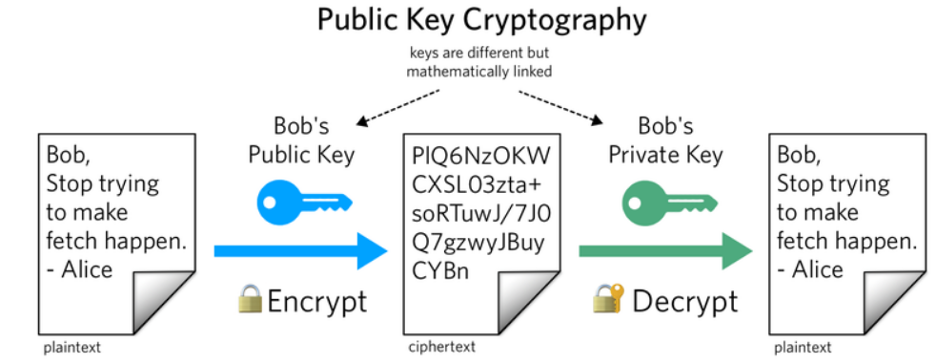
Mad Hedge Bitcoin Letter
August 4, 2022
Fiat Lux
Featured Trade:
(ANOTHER CRYPTO HACK)
(SOL), (BTC), (ETH)

The price of Bitcoin is holding up quite well in the short-term as Robinhood fires 23% of its workforce, Bitcoin cheerleader and now former CEO of MicroStrategy quits his post, and another security debacle.
Security infrastructure in any unregulated market is paramount simply because the assets aren’t insured.
Once taken, might as well gift the robbers a card on the way out.
The stakes become higher when hackers know they are less likely to be chased after or quantified once they steal what they are looking for.
Regulated and insured industries are tied to government oversight and when that’s the case, congressional committees often look into industries they are directly tied to if things run amuck.
The optics couldn’t be worse for crypto as we bounce from consecutive security breakdown to the next.
It’s almost as if the last coin not getting hacked will be the last one standing.
It’s getting that bad as the crypto “winter” has triggered a wave of bankruptcies and encouraged smash-and-grab hacking schemes preying on crypto holders who are down and out.
This time it was Solano, which is the 4th biggest cryptocurrency, with a market cap only behind Cardano (ADA), Ethereum (ETH), and the bellwether Bitcoin (BTC).
Solana, known for its speedy transactions, has become the target of the crypto most recent hack after users reported that funds have been drained from internet-connected “hot” wallets.
An unknown actor drained funds from 7,767 wallets on the Solana network resulting in upwards of potentially $50-$100 million.
The attack – which has affected only “hot” wallets or wallets that are always connected to the internet, allowing people to store and send tokens easily – does not appear to be limited to Solana.
Users have reported that USDCs were emptied as well.
The attack has compromised other wallets including Phantom, Slope, Solflare, and TrustWallet. Wallets drained should be treated as compromised and abandoned, Solana warned as it encouraged users to switch to hardware or “cold” wallets.
Phantom, a fast-growing Solana-based wallet that hit $1.2 billion in valuation in January, said it’s “working closely with other teams to get to the bottom of a reported vulnerability in the Solana ecosystem.”
Developers still don’t know how the hack happened and might never figure it out.
The hackers are that far ahead of the game.
Solana spokesperson Chris Kraeuter said the company’s engineers “are currently working with multiple security researchers and ecosystem teams to identify the root cause of the exploit, which is unknown at this time.”
The Solana attack comes hot on the heels of hackers exploiting almost $200 million in digital assets from cross-chain messaging protocol Nomad.
The “free-for-all” attack, which saw more than 41 addresses drain $152 million — 80% of the stolen funds – was made possible by a recent update to one of Nomad’s smart contracts that made it easy for users to spoof transactions.
The word is out there and hackers are clued up, they are moving fast to take advantage of the green shoots nature of the security infrastructure.
An infrastructure not tested by time is prone to gaps in defense and that is what we are seeing.
I have the conviction that if the bellwether Bitcoin is taken down by hackers, that could be the beginning of the end for crypto for this iteration.
In that unlikely scenario, we will experience a precipitous drop from the $23,000 per coin today.
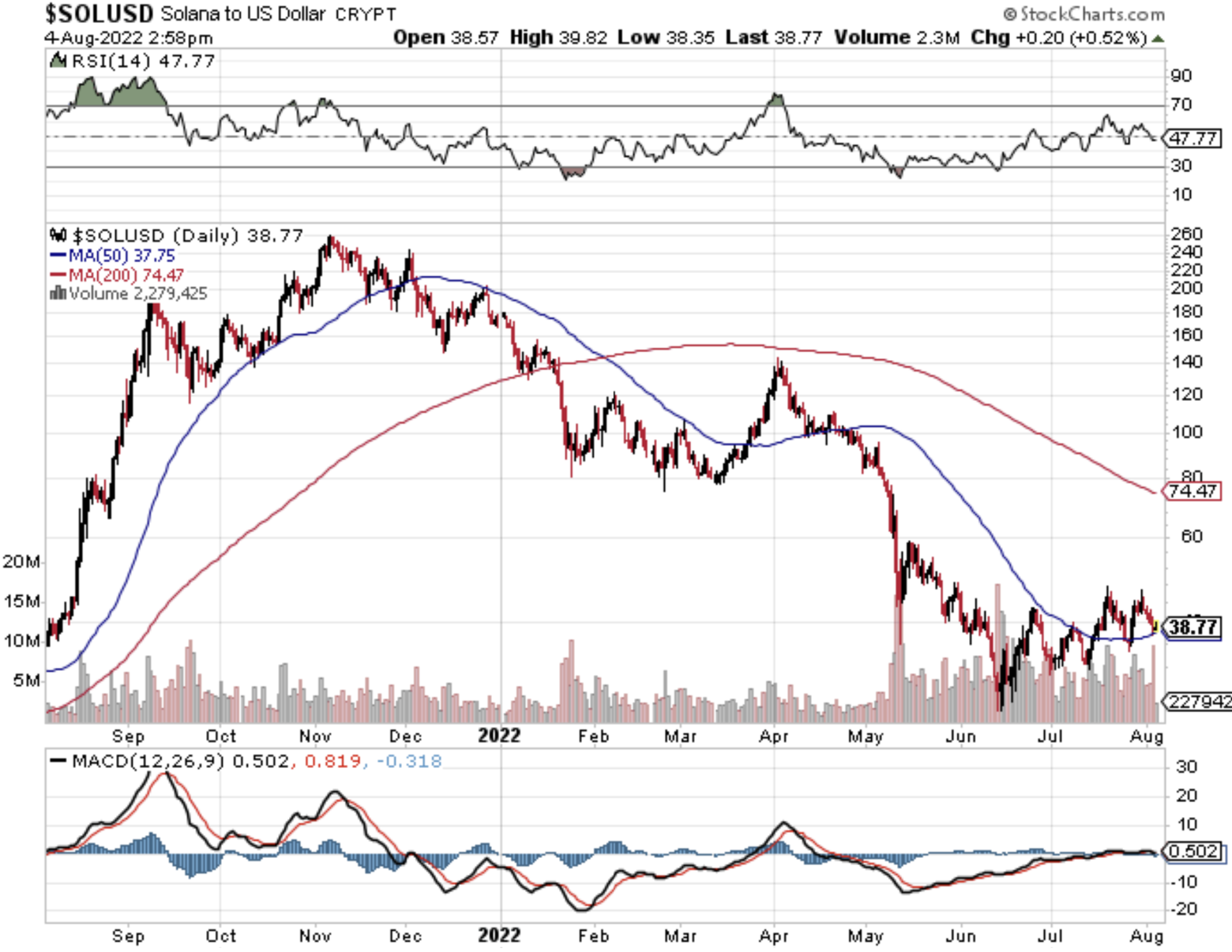

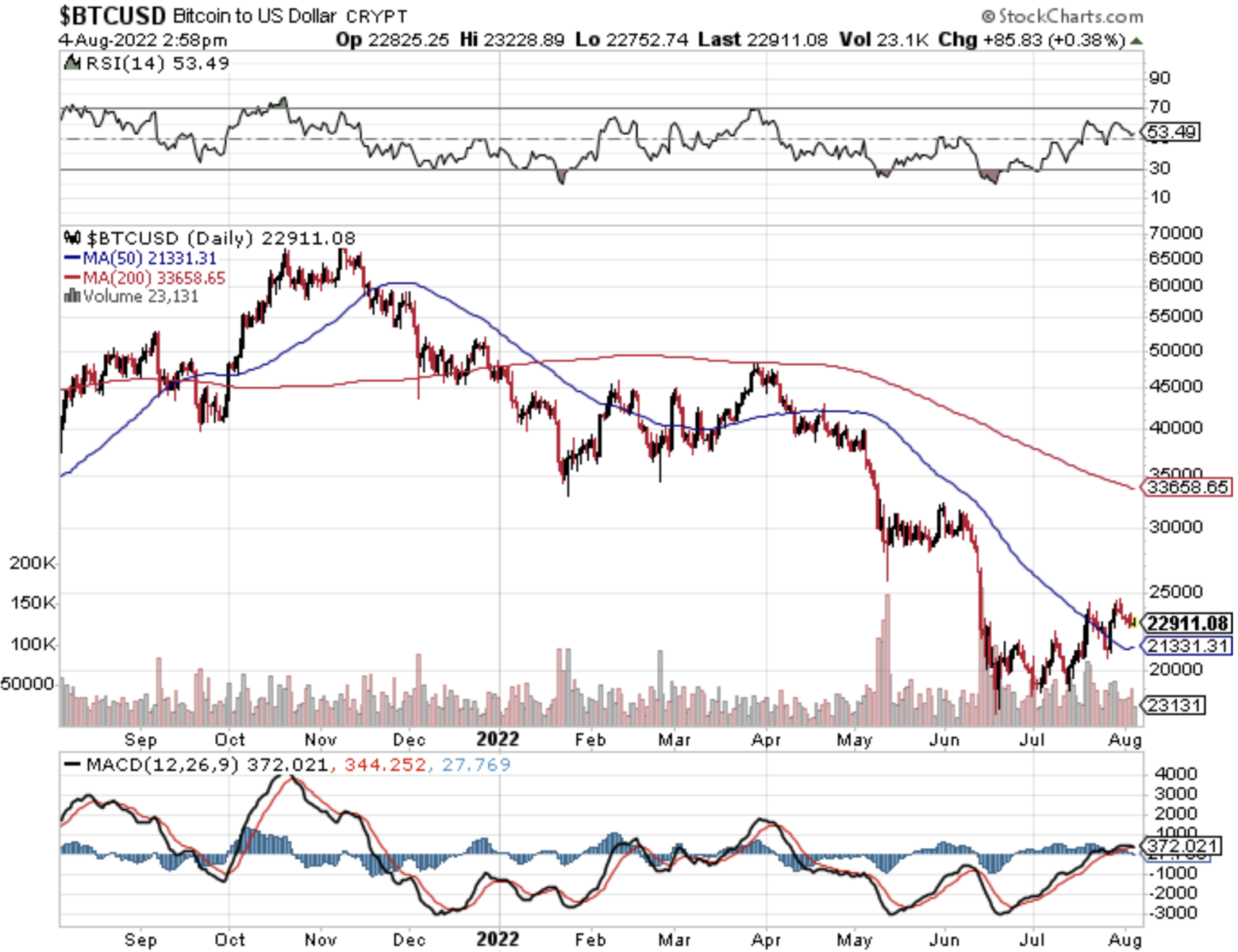
Mad Hedge Bitcoin Letter
August 2, 2022
Fiat Lux
Featured Trade:
(POWELL BOOSTS CRYPTO)
(BTC), (ETH)

After Bitcoin’s nosedive from $31,000 to $19,000, the digital gold has transitioned into a phase of low volatility.
This lull has helped out stabilize the asset class.
At one point, $12,000 was on the table but now, as recessionary fears have started to creep back into the market psyche, an expectation of loosening the liquidity regime appears to be in the cards.
Or so that is what the market is pricing in and when we look at the Fed Funds rate, it shows a forecast of interest rate cuts starting after March 2023.
Interest rate cuts are highly bullish for cryptocurrency because lower interest rates mean easier access to borrowing money to pour into alternative assets like crypto.
The tighter the money policy, the more conservative investors become preferring to invest in real estate and energy assets.
This year certainly hasn’t been the year of Bitcoin, yet we roll into the last half of the year hoping that 2023 will deliver rate cuts to crypto traders.
Positive signs have been filtering through following the Federal Reserve's announcement to raise interest rates by 75 basis points, bitcoin climbed over $24,000.
Ethereum has more than doubled bitcoin’s gains over the same period, jumping as much as 57%.
The future expectation of rate cuts has been boosted because of US Central Bank Governor Jerome Powell’s weak testimony.
Signaling the bringing forward of rate cuts because a recession could come is bullish Bitcoin.
However, the current problem we have is 9.1% inflation devouring the 2.5% Fed Funds rate.
The probable result is when the Fed finally does pivot to a more dovish stance, it will do so while admitting defeat to inflation.
In the most recent Cleveland Fed inflation expectations, July is estimated to be 8.8%.
To be sure, the total market capitalization for all crypto assets is still down roughly 60% from its peak reached in November 2021. But cryptocurrency prices have rebounded over the first half of July with fresh buying having sent the sector's total market cap back above $1 trillion.
The 200-day moving average (DMA), which traders use as a technical gauge for whether an asset's trend is broadly higher or lower, still sits far above current levels and is declining for both bitcoin and ether.
As far as crypto fundamentals go, Ethereum's merger is a potential positive for markets through the summer. Core developers of the Ethereum blockchain have slated its software upgrade from proof-of-work to proof-of-stake, the so-called "Merge," for as early as the week of September 19.
People like hearing hard dates and we are still waiting for one from Ethereum.
Ultimately, what is abundantly clear is that the lack of appetite to raise rates is good news for all risk assets as we move forward into 2023.
This means we won’t see a repeat of a disastrous sell-off that occurred the past year in crypto.
Since the middle of June, the bitcoin dip has been bought and I can easily see a scenario where crypto continues to inch up if inflation comes down to a 5-7% range which is entirely possible.
Crypto, the industry itself, has a lot of work to do, but the macro picture is what is powering the price right now.
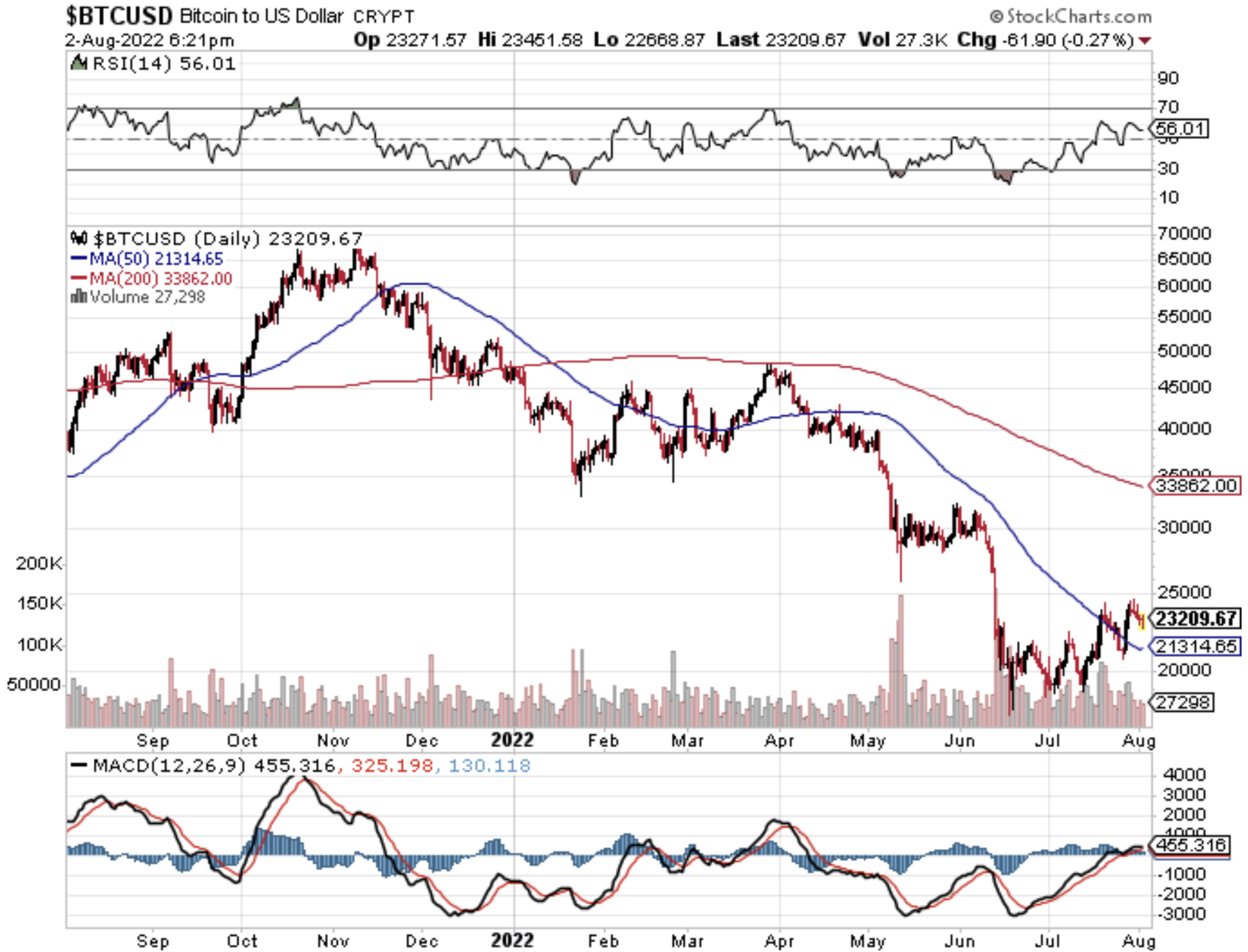
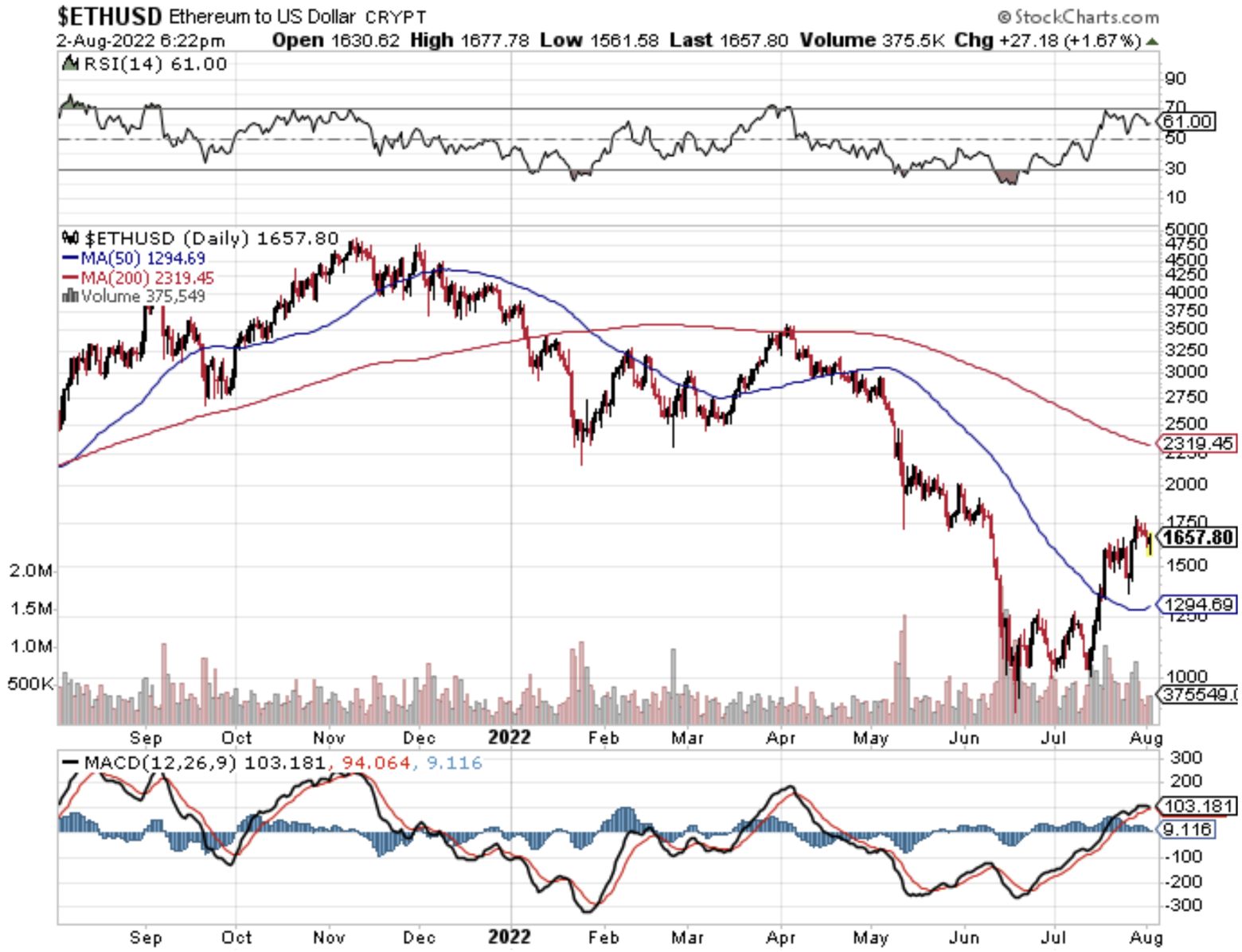
Mad Hedge Bitcoin Letter
July 14, 2022
Fiat Lux
Featured Trade:
(BITCOIN OR ETHEREUM)
(BTC), (ETH)

In the crypto community, investors fiercely defend why Bitcoin (BTC) will be more valuable than Ethereum (ETH) or vice versa in the future.
It was only just last year, we were presented with a situation where both were going up, and primarily because of the law of numbers, the growth rates for ETH were higher because the coin was priced in the low thousands.
When the pronounced equity selloff started to really accelerate at the beginning of this year, it offered a snapshot into which currency is best suited to endure heavy systemic stress.
The winner, and not even close I might add, was and still is Bitcoin.
Saying Ethereum has been having a hard time is an understatement, it has sunk from a peak of $4,800 to $1,000 today.
In relative terms, BTC has outperformed ETH by around 40% during this equity turmoil showing itself as still the best in show and the only reasonable crypto to invest in.
I am on record for saying ETH would be higher than BTC in the future earlier last year because of the accelerated growth input of the asset in a growth industry.
That all changed once the dynamics reversed and tailwinds became headwinds, and now, we are really witnessing ETH’s true colors.
It simply isn’t as good as BTC period.
I have heard of some pundits pushing back the timeline of when ETH will surpass BTC to 2030.
I would respond by saying what is that based on?
Hope?
I do believe the upcoming system shift to proof-of-stake (PoS) will take absolutely no part in ETH usurping the crypto throne ten years from now.
Investors don’t care if the coin is produced using hydrocarbon energy or windmills.
It’s not really a big deal to them.
I would probably say it will never happen, pointing out that BTC is digital gold while ETH is the second iteration of the internet.
I have seen nothing that suggests that ETH's software or code is so much superior to that of BTC so much so that we are about to experience a revolutionary shift.
It’s not that at all.
To say that “there’s plenty of room for both” is also something I don’t agree with because I believe this is a winner take all type of proposition which is an inherent dynamic embedded in technology.
There are over 20,000 crypto coins and most of them are scams.
Even if ETH reduces hydrocarbon energy and increases its security, that doesn’t mean that BTC will have less security advances relative to ETH over time.
Even more ironic is the PoS switch means that the system will need to run a validator as the backbone of the network.
The validator is expected to maintain sufficient hardware and connectivity to participate in block validation and proposal.
In return, the validator is paid in ETH (their staked balance increases).
Validators miss out on ether rewards if they fail to participate when called upon, and their existing stake can be destroyed if they behave dishonestly.
Once activated, validators receive new blocks from peers on the Ethereum network.
No offense, this sounds like a centralized version of ETH and not a decentralized coin.
Proof-of-work is when any random guy can hook up to a power grid and produce a BTC which he can take proceeds from. He has no control over the system and nobody knows who he is.
The validators being held by a code of conduct and penalized or rewarded by that is absolutely what I consider centralization.
Ultimately, I don’t believe ETH has any special advantage over BTC and the PoS switch is a lot of marketing chutzpah.
The fact is that BTC has outperformed ETH when the equity sushi hit the fan and honestly, who cares about PoS.
Investors care about preserving the value of their portfolios.
If a choice between one, invest in BTC and avoid ETH.
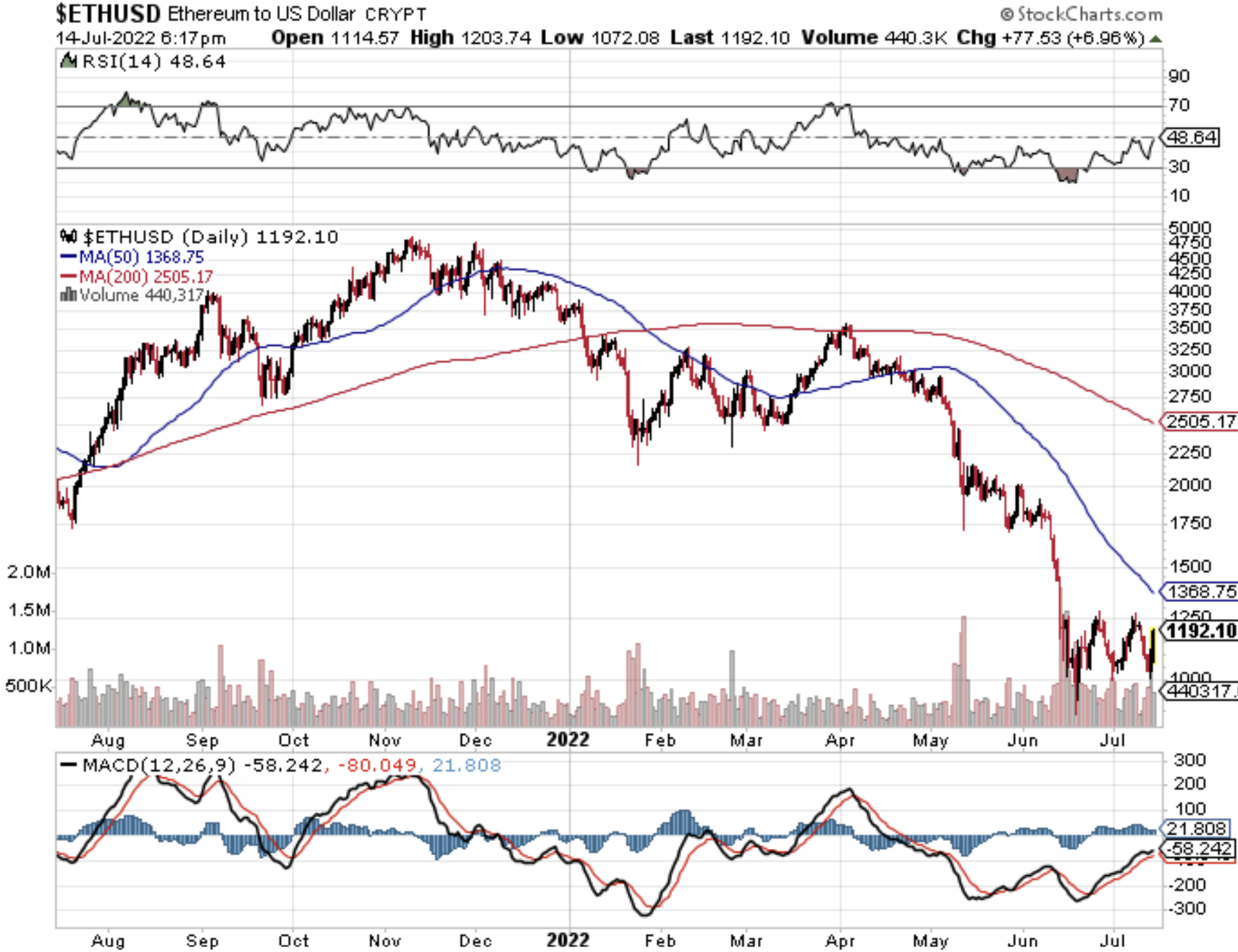
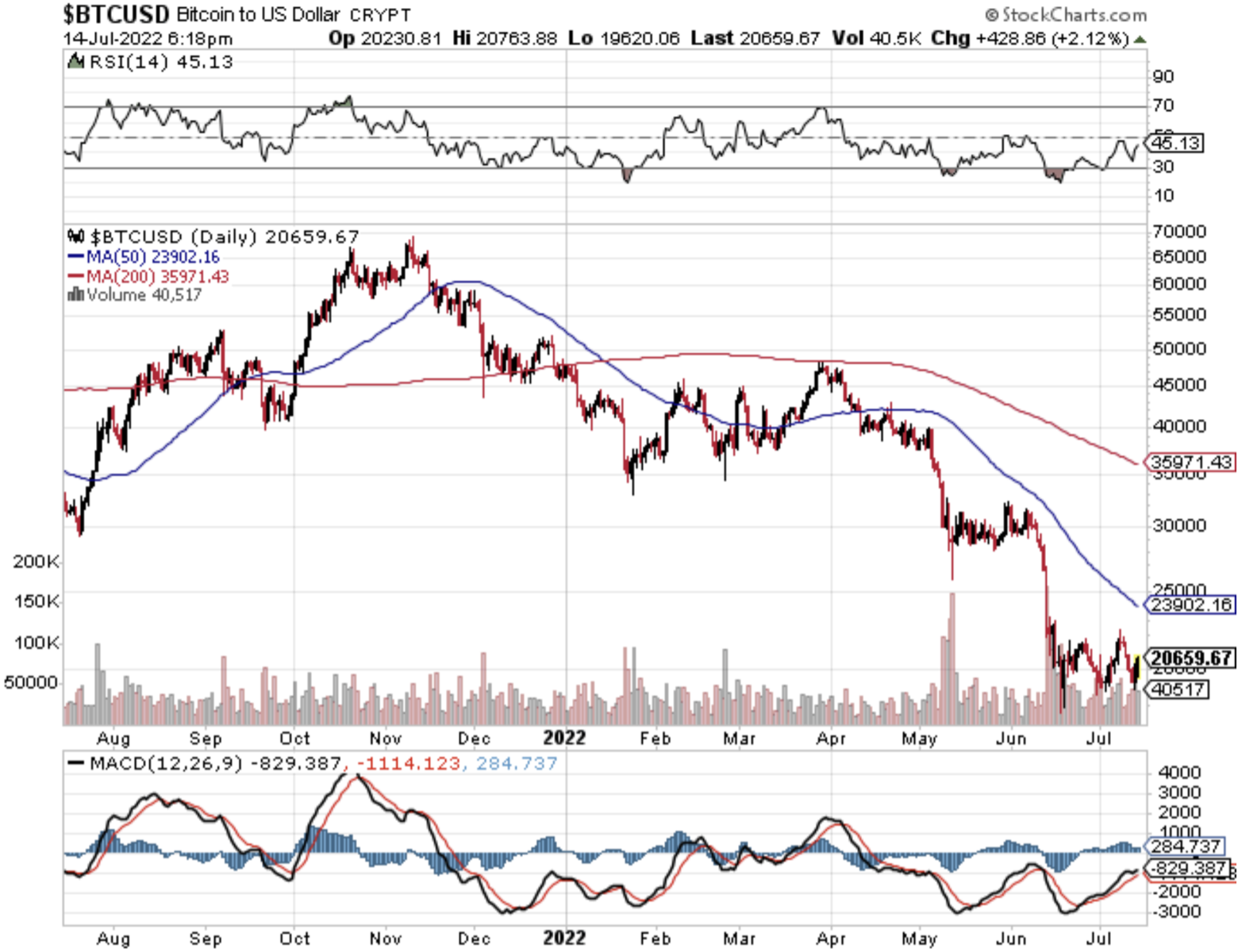
Mad Hedge Bitcoin Letter
June 2, 2022
Fiat Lux
Featured Trade:
(OFFLINE CRYPTO)
(BTC), (ETH), (SOL), (ADA), (XRP)

One of the first requirements to be anointed as a major cryptocurrency is to not be off.
This might seem highly intuitive, but many cryptocurrencies haven’t solved this one yet.
When a whole coin network is offline then the incremental investors look over to the greener pastures on the other side of the fence and ponder if it’s worth paying a higher premium for something that stays on.
Bitcoin can’t be turned off. Invest accordingly.
According to the Bitcoin Uptime Tracker, the Bitcoin network has been functional for 99.98742319836% of its lifetime.
I would consider that quite positive, even more so when I look at just what happened to altcoin Solana (SOL) which has been bundled routinely into the top 5 cryptocurrency conversation.
The Solana network has been plagued by a number of outages and it's been estimated that the proof-of-stake (PoS) blockchain has been down a total of eight times.
Each of these 8 times, the network suffers a massive loss of trust and confidence.
When an investor can’t get in touch with its capital on a network, that’s when full stop panic mode occurs.
It dumps insult to injury as the price has already tanked from $260 to $40 today.
Solana’s blockchain lost operational activity for over seven hours.
Solana’s development team has formally acknowledged some of the issues it was dealing with and how it “degraded performance.”
The team blamed “high compute transactions, which is reducing network capacity to several thousand transactions per second.”
Like many of the cloud companies plan for higher data usage by integrating more cloud data centers, the developers at Solana aren’t pre-emptively planning for bottlenecks.
That screams amateurism.
An investor must ask if this is the type of coin or network you want to put significant amounts of money on, and the answer is clearly no.
Only a fool would touch Solana even with its lofty $14 billion market cap.
Of course, with Solana going down again, the backlash has been relentless.
Many have joked if this is another Terra/Luna bankruptcy debacle even if Solana isn’t a stable coin.
Meanwhile, this gives credence to why investors should look to other coins such as ETH, XRP, and cardano (ADA).
Then there is the pure asset depreciation from being offline and SOL lost 9.9% in value against the U.S. dollar.
Coinbase also reported on Solana’s latest outage and noted that the exchange had to disable send and receives on the network.
Following last month's outage, one of Solana's recent improvements was supposed to resolve the network's congestion difficulties.
It’s not a secret that instead of a significant network update, the inverse has happened, and the Solana network issues have gotten worse.
Even worse, the repeated solutions appear to be mere stopgap measures with a high possibility of happening again.
These are terrible optics for a beleaguered crypto coin at a time when the entire industry is on the back foot.
The bellwether crypto coin Bitcoin has lost over half of its value triggering talks of a crypto winter.
Then mix in various implosions, developer mistakes, and high energy costs making crypto unprofitable to miners and there is a lot of negativity coalescing inside the industry.
In short, stick with the strongest cryptocurrencies namely Bitcoin and Ethereum, and don’t stray much further than that unless you are prepared to take a zero.
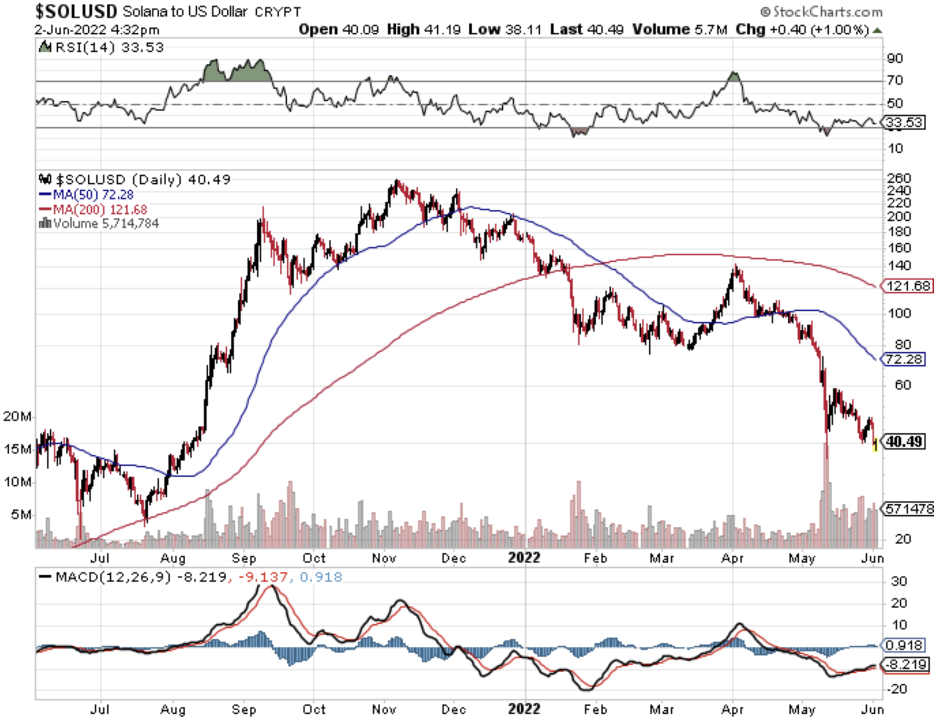
Legal Disclaimer
There is a very high degree of risk involved in trading. Past results are not indicative of future returns. MadHedgeFundTrader.com and all individuals affiliated with this site assume no responsibilities for your trading and investment results. The indicators, strategies, columns, articles and all other features are for educational purposes only and should not be construed as investment advice. Information for futures trading observations are obtained from sources believed to be reliable, but we do not warrant its completeness or accuracy, or warrant any results from the use of the information. Your use of the trading observations is entirely at your own risk and it is your sole responsibility to evaluate the accuracy, completeness and usefulness of the information. You must assess the risk of any trade with your broker and make your own independent decisions regarding any securities mentioned herein. Affiliates of MadHedgeFundTrader.com may have a position or effect transactions in the securities described herein (or options thereon) and/or otherwise employ trading strategies that may be consistent or inconsistent with the provided strategies.
This site uses cookies. By continuing to browse the site, you are agreeing to our use of cookies.
OKLearn moreWe may request cookies to be set on your device. We use cookies to let us know when you visit our websites, how you interact with us, to enrich your user experience, and to customize your relationship with our website.
Click on the different category headings to find out more. You can also change some of your preferences. Note that blocking some types of cookies may impact your experience on our websites and the services we are able to offer.
These cookies are strictly necessary to provide you with services available through our website and to use some of its features.
Because these cookies are strictly necessary to deliver the website, refuseing them will have impact how our site functions. You always can block or delete cookies by changing your browser settings and force blocking all cookies on this website. But this will always prompt you to accept/refuse cookies when revisiting our site.
We fully respect if you want to refuse cookies but to avoid asking you again and again kindly allow us to store a cookie for that. You are free to opt out any time or opt in for other cookies to get a better experience. If you refuse cookies we will remove all set cookies in our domain.
We provide you with a list of stored cookies on your computer in our domain so you can check what we stored. Due to security reasons we are not able to show or modify cookies from other domains. You can check these in your browser security settings.
These cookies collect information that is used either in aggregate form to help us understand how our website is being used or how effective our marketing campaigns are, or to help us customize our website and application for you in order to enhance your experience.
If you do not want that we track your visist to our site you can disable tracking in your browser here:
We also use different external services like Google Webfonts, Google Maps, and external Video providers. Since these providers may collect personal data like your IP address we allow you to block them here. Please be aware that this might heavily reduce the functionality and appearance of our site. Changes will take effect once you reload the page.
Google Webfont Settings:
Google Map Settings:
Vimeo and Youtube video embeds:
